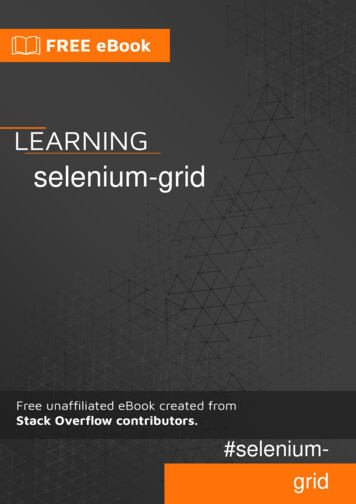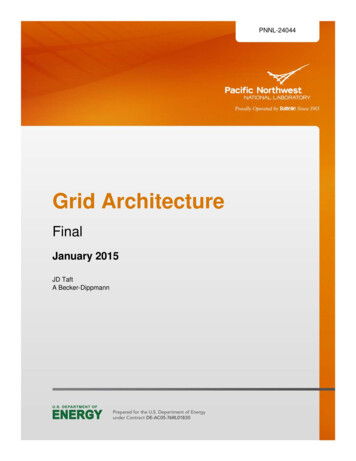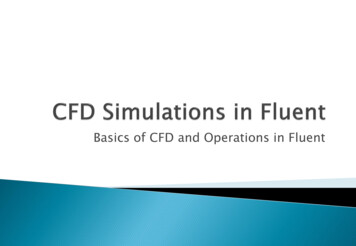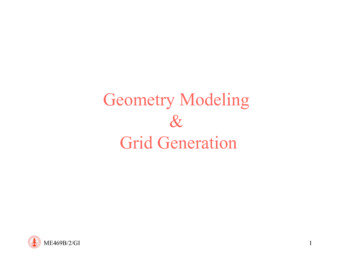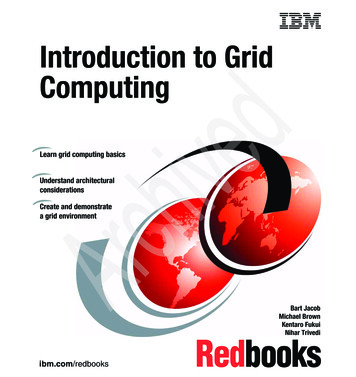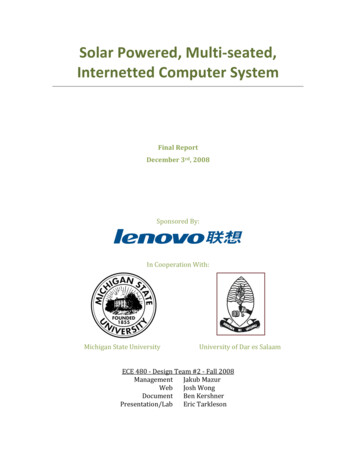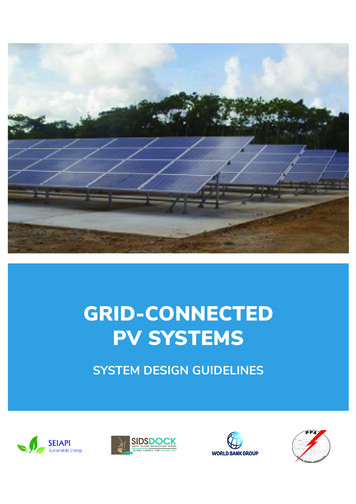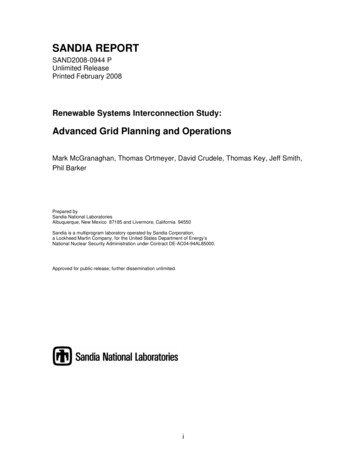
Transcription
SANDIA REPORTSAND2008-0944 PUnlimited ReleasePrinted February 2008Renewable Systems Interconnection Study:Advanced Grid Planning and OperationsMark McGranaghan, Thomas Ortmeyer, David Crudele, Thomas Key, Jeff Smith,Phil BarkerPrepared bySandia National LaboratoriesAlbuquerque, New Mexico 87185 and Livermore, California 94550Sandia is a multiprogram laboratory operated by Sandia Corporation,a Lockheed Martin Company, for the United States Department of Energy’sNational Nuclear Security Administration under Contract DE-AC04-94AL85000.Approved for public release; further dissemination unlimited.i
Issued by Sandia National Laboratories, operated for the United States Departmentof Energy by Sandia Corporation.NOTICE:This report was prepared as an account of work sponsored by an agency of theUnited States Government. Neither the United States Government, nor any agency thereof,nor any of their employees, nor any of their contractors, subcontractors, or their employees,make any warranty, express or implied, or assume any legal liability or responsibility for theaccuracy, completeness, or usefulness of any information, apparatus, product, or processdisclosed, or represent that its use would not infringe privately owned rights. Reference hereinto any specific commercial product, process, or service by trade name, trademark,manufacturer, or otherwise, does not necessarily constitute or imply its endorsement,recommendation, or favoring by the United States Government, any agency thereof, or any oftheir contractors or subcontractors. The views and opinions expressed herein do notnecessarily state or reflect those of the United States Government, any agency thereof, or anyof their contractors.Printed in the United States of America. This report has been reproduced directly from the bestavailable copy.Available to DOE and DOE contractors fromU.S. Department of EnergyOffice of Scientific and Technical InformationP.O. Box 62Oak Ridge, TN 37831Telephone: .osti.govE-Mail:Online ordering: http://www.osti.gov/bridgeAvailable to the public fromU.S. Department of CommerceNational Technical Information Service5285 Port Royal RdSpringfield, VA 22161Telephone: dworld.govE-Mail:Online order: http://www.ntis.gov/help/ordermethods.asp?loc 7-4-0#onlineii
SAND2008-0944 PUnlimited ReleasePrinted February 2008Renewable Systems Interconnection Study:Advanced Grid Planning and OperationsMark McGranaghan,Thomas Ortmeyer,David Crudele,Thomas Key,Jeff Smith,Electric Power Research InstitutePhil Barker,Nova Energy Specialists, LLCSandia Contract 715908AbstractTo facilitate more extensive adoption of renewable distributed electric generation, theU.S. Department of Energy launched the Renewable Systems Interconnection (RSI) studyduring the spring of 2007. The study addressed the technical and analytical challengesthat must be addressed to enable high penetration levels of distributed renewable energytechnologies. This RSI study addresses grid-integration issues as a necessary prerequisitefor the long-term viability of the distributed renewable energy industry, in general, andthe distributed PV industry, in particular.iii
iv
PrefaceNow is the time to plan for the integration of significant quantities of distributed renewableenergy into the electricity grid. Concerns about climate change, the adoption of state-levelrenewable portfolio standards and incentives, and accelerated cost reductions are drivingsteep growth in U.S. renewable energy technologies. The number of distributed solarphotovoltaic (PV) installations, in particular, is growing rapidly. As distributed PV and otherrenewable energy technologies mature, they can provide a significant share of our nation’selectricity demand. However, as their market share grows, concerns about potential impactson the stability and operation of the electricity grid may create barriers to their futureexpansion.To facilitate more extensive adoption of renewable distributed electric generation, the U.S.Department of Energy launched the Renewable Systems Interconnection (RSI) study duringthe spring of 2007. This study addresses the technical and analytical challenges that must beaddressed to enable high penetration levels of distributed renewable energy technologies.Because integration-related issues at the distribution system are likely to emerge first for PVtechnology, the RSI study focuses on this area. A key goal of the RSI study is to identify theresearch and development needed to build the foundation for a high-penetration renewableenergy future while enhancing the operation of the electricity grid.The RSI study consists of 15 reports that address a variety of issues related to distributedsystems technology development; advanced distribution systems integration; system-leveltests and demonstrations; technical and market analysis; resource assessment; and codes,standards, and regulatory implementation. The RSI reports are: Renewable Systems Interconnection: Executive Summary Distributed Photovoltaic Systems Design and Technology Requirements Advanced Grid Planning and Operation Utility Models, Analysis, and Simulation Tools Cyber Security Analysis Power System Planning: Emerging Practices Suitable for Evaluating the Impact ofHigh-Penetration Photovoltaics Distribution System Voltage Performance Analysis for High-PenetrationPhotovoltaics Enhanced Reliability of Photovoltaic Systems with Energy Storage and Controls Transmission System Performance Analysis for High-Penetration Photovoltaics Solar Resource Assessment Test and Demonstration Program Definition Photovoltaics Value Analysis Photovoltaics Business Modelsv
Production Cost Modeling for High Levels of Photovoltaic Penetration Rooftop Photovoltaics Market Penetration Scenarios.Addressing grid-integration issues is a necessary prerequisite for the long-term viability of thedistributed renewable energy industry, in general, and the distributed PV industry, inparticular. The RSI study is one step on this path. The Department of Energy is also workingwith stakeholders to develop a research and development plan aimed at making this vision areality.vi
List of IAvoltage changeAmerican National Standards Institutebroadband over power linecompressed air energy storageConsortium for Electric Reliability Technology SolutionsAmerican Electric Powercombined heat and powercombustion turbinedistributed energy resourcesdistributed generators or generationU.S. Department of Energydistributed resourcesDistributed Utility Integration Testenergy exceeding normalenergy management systemsElectric Power Research InstituteFederal Communications Commissionhigh voltagepower flow lossesIntelliGrid Architectureinternal combustion engineInternational Electrotechnical CommissionInstitute of Electrical and Electronics Engineersinsulated gate bipolar transistorsindependent system operatorintelligent universal transformerlevelized cost of energyload tap changinglow voltagemolten carbonate fuel cellsMicrogrid Energy Managementmedium voltageNational Renewable Energy LaboratoryNational Technical University of Athensoutage management systemphosphoric acid fuel cellsplug-in hybrid electric vehiclesPublic Utility Regulatory Policies Act (1978)photovoltaicspulse-width modulatedRenewable Systems Interconnectionremote terminal unitsupervisory control and data acquisitionSolar Energy Industries Associationvii
SMESSNLT&DTCULVACVARWGsuperconductive magnetic energy storageSandia National Laboratoriestransmission and distributionTechnical Committee (of the IEC)Underwriters Laboratoriesvolts alternating currentvolt ampere reactiveWorking Goal (of the IEC TC)viii
Executive SummaryThe electric grid enables PV generation by delivering available renewable power systemoutput to the larger energy market. The grid simplifies the balancing of variations in supplyand demand of individual distributed generators over a wide area. This service improvesdistributed generator economics and reduces the requirement for adding energy storage. Acritical challenge—and the subject of this study—is that significant deployment of PV energyrequires modernization of the distribution grid. Grid change needs depend on the level ofdeployment, the existing distribution configuration, and the PV system design. R&D isneeded to define what future electric distribution will look like and how the existingdistribution system can evolve to this new design.This report looks at issues and options for increasing the penetration of renewable generation.The distribution grid was designed and built and is operating for centralized generation. Withlimited capacity for reversing power flows and without control and communication at thepoint of use, our existing distribution grid is not equipped to realize the full potential ofdistributed PV generation. Gradual—and not necessarily system-wide—evolution is neededand should be appropriate for the level of penetration at a substation or feeder level. Otheropportunities to improve the distribution and use of electricity such as load management,advanced metering, and demand control are considered in this report, along with distributedrenewable generation.Two evolutions are envisioned. The first is distributed PV systems that operate interactivelywith available solar resources, varying conditions on the grid, and other local resources,including load control and future generation and storage resources. The second, and perhapsmore challenging, evolution is that the distribution grid will need to be reinvented to interactwith and in some cases control distributed generation and load demand. This will in turnmake the grid more compatible with “grid-ready” distributed PV systems.To support this vision, a strategy is needed to move from the relatively small PV energymarket of “passively interacting” systems to a PV system that is an “active partner” in thegrid. A key element of this strategy is that the PV system will help to meet system energydemand and control requirements at all grid levels, including transmission and independentsystem operators. Another element is recognition of the large existing capital investment indistribution, which will require a long-term and deliberate effort to change.A key conclusion of this work is that significant coordination, planning, and related R&Dwill be required to ensure that the evolution is done intelligently. This “smart” evolutionincludes other necessary system changes, such as allowing for increasing distributionautomation, automated load controls, and greater facilitation of features that enhance powerquality and reliability. These features can be part of a 21st-century grid that is more reliable,has improved long-distance power transaction flexibility, and is ready for widespread PVenergy systems.ix
Three areas are addressed in this report: Evolutionary change to enable high penetration 21st-century power distribution and PV compatibility The future for microgrids.Evolutionary Change to Enable High PenetrationIn the history of efforts to deploy and apply distribution generation, significant progress hasbeen made with interconnection standards and with the recognition that changes must bemade in power distribution design and operation in the future. This began with the PublicUtility Regulatory Policies Act (PURPA) of 1978, which provided a framework and allowedcogeneration with the electric grid. Larger conventional types of distributed generators (DG)were installed on a case-by-case basis. With a wider variety of smaller generators, moreuniform connection rules were developed. As penetration levels increase, however,traditional grid system operation and controls require change (with a few exceptions). Ingeneral, distributed resources passively interact with the grid.With the growth and success of wind generation and aggregation into large wind farms attransmission and subtransmission levels, the operating rules have evolved to more activeinteraction with and support of the grid. As distribution-level distributed generation grows tohigher penetration levels, two evolutions are seen. The first is that distribution generationbegins to operate interactively with both the conditions on the grid and with other localresources, including load control and, in the future, other generation and storage resources.The second and perhaps more challenging evolution is that the distribution grid will need tobe redesigned and rebuilt, perhaps reinvented, to be more compatible with the newrequirements of distributed energy systems.Table ES-1 shows this evolution of distributed energy (note that stand-alone operation, suchas microgrids that are disconnected from the electric grid, is not included in this table).x
Table ES-1. Evolution of Distribution EnergyFossil FueledCogeneration (PURPA)(1978 to mid-1990s)Emerging Gas andRenewable DG(mid-1990s to present)Penetration LevelLess than 2% of bulkgeneration energyLess than 10%Growing to 20% and greaterDeploymentStrategy ofDistributed PVTo provide initial legaland technical frameworkto allow grid connectionof independent powerproducersTo facilitate adeveloping market forsmall to mid-sizedpassively interactingDGDG becomes an activepartner in helping to meetsystem energy demand andcontrol requirements at allgrid levelsLevel of SystemWhere Strategy IsFocusedNot addressedDistributionsystem levelDistribution and bulk systemlevelsLevel of PVCompliance withthe Electric PowerSystemLocation-specificrequirements; mainconcerns are trip limits,safety, and protectionUniform requirements forpower quality and activeparticipation in powersystem operationElectric PowerSystem ChangesTo EnablePenetrationNo special proactivedesign considerationsSystem-specificrequirements forpower quality,islanding protection,and passive systemparticipationSome proactivedesign considerations,mostly minor changessuch as slowerreclosingParameter ofInterestMaturing Renewable DGand Load Control(near future and beyond)Significant protection,control, grounding, andcommunication designchanges to implement highpenetrationThe transition to active distributed PV systems and a distribution system that is ready forintegration of these systems will not be achieved abruptly. Such a sudden shift would disruptexisting power delivery and require too much new capital investment. Distributed generationis operating now in compliance with utility voltage limits, and high penetrations can beachieved with the use of adaptive, autonomous local control systems that operate underutility supervision, as well as with the use of rapid, inverter-based fault current limiting.Considerable time will be required, however, to fully integrate these distributed systems withautomated distribution management systems (involving investments by both utilities and PVsystem manufacturers). A key conclusion of this work is that significant coordination,planning, and related R&D will be required to ensure that the evolution proceeds in anintelligent fashion and includes other necessary system changes, which could includeincreasing distribution automation, adding automated load controls, and building in featuresthat enhance power quality and reliability. These features can be part of a 21st-century gridthat is more reliable, has improved long-distance power transaction flexibility, and is morecompatible with distributed PV generation.xi
Overarching the technical challenges of increasing penetration levels is the need for changein the traditional business case for generation and delivery of electric power. In looking to thefuture requirements for implementation of distributed resources, the research plan and agendamust promote both central and distributed power system concepts with a view to optimizingsystem efficiency and economics. It is critical that research is directed to creatingopportunities on both sides of the meter that lead to a “market-driven response” forreinventing the electric grid.Power Distribution and PV CompatibilityIn the future, generation of distribution will be more automated and ready to interact withdistributed PV and other distribution-connected energy resources. Distribution automationand smart grids will apply to all the elements of the distribution system: Individual customers (meters and loads) and at the transformers or groups ofcustomers (including intelligent universal transformers) Intelligent load-control devices on the distribution system Distributed generation and storage, including local energy control systems, rooftopsolar, and eventually plug-in electric vehicles Intelligent switches, breakers, and reclosers on the feeder Substation data management Planning area data management.There is general agreement that all of these elements, as well as related opportunities andchallenges, must be considered together so as to best apply new technologies to meet today’schallenges for the distribution system. As a result, several efforts have emerged to addressthese issues: The Gridwise Consortium, led by the U.S. Department of Energy, Washington, D.C. The Intelligrid Consortium, led by the Electric Power Research Institute, Palo Alto,California The Avanti Distribution Circuit of the Future project, led by Southern CaliforniaEdison, Rosemead, California The DisPower project, coordinated by ISET, Kassel, GermanyIn addition to these projects, national laboratories, power companies, universities, andequipment manufacturers around the globe are undertaking numerous research activities.Overall, the ongoing development and implementation of distribution automation is asynergistic activity that is partially driven by the need to accommodate and to controldistribution-level resources. There is no doubt that an automated distribution system will bemore interactive with distributed PV systems than the current systems. This, in turn, willenable better utilization of resources and higher penetration. The requirements for highpenetration PV will generally include the following:xii
Interactive voltage regulation and volt ampere reactive (VAR) management.Utility voltage-regulator and capacitor controls will be interactive with each other andthe DG sources. A central controller, such as that depicted in Figure ES-1, will helpmanage the interactivity to ensure optimized voltage and reactive power conditions.Note: LTC load tap changingFigure ES-1. Distributed controller results are aggregated to manage area power and systemvoltage profiles Bulk system coordination of DG. For market and bulk system control, DG will needto be controlled from a dispatch center. This will allow DG to participate and beaggregated into energy markets as well as to preserve system stability, power quality,and reliability at the bulk level. Protective relaying schemes designed for DG. The distribution and subtransmissionsystems will include more extensive use of directional relaying, communicationbased transfer trips, pilot signal relaying, and impedance-based fault-protectionschemes (like those used in transmission). These can work more effectively withmultiple sources on the distribution system. Advanced islanding control. To improve the ability to detect unintentional islands,switchgear will need to be extensively automated and DG will need enhancedislanding detection capabilities. In addition, these systems should be able toreconfigure the grid/DG into reliability-enhancing “intentional islands.” Interactive service restoration. Sectionalizing schemes for service restoration allowdistributed PV and other DG to help pick up load during the restoration process, asshown in Figure ES-2. Once separated, these must deal effectively with overloadsfrom cold-load pickup and the current inrush required to recharge the system.xiii
tch B(3rd to close)Switch C(Last to close)FEEDERCircuit Breaker(first to close)LoadArea 1Switch A(2nd to close)RotatingMachineSourceLoadArea 2LoadArea 3PVInverterSourceLoadArea 4Figure ES-2. Illustration of cascaded restoration of DG Improved grounding compatibility. In both DG and distribution, new devices andarchitectures must be considered that address grounding incompatibilities amongpower system sensing, protection, and harmonic flows. Examples of these techniquesareo Control or limit ground fault overvoltage via relaying techniques or ancillary devicesinstead of effectively grounded DG requirementso Harden the power system and loads to be less susceptible to ground fault overvoltage(increase voltage withstand ratings)o Change protective relaying for ground faults so a high penetration of groundingsources does not affect the ground fault relayingo Change feeder grounding scheme or load serving scheme back to a grounded threewire system. Employ distributed energy storage. Energy storage of various forms will apply tocorrect temporary load/generation mismatches, regulate frequency, mitigate flicker,and assist advanced islanding functions and service restoration.These system changes and technology upgrades not only represent an extensive investmenton the part of government, electric utilities, and equipment manufacturers, but also a hugechange in the way the power system is operated and designed. These changes will not beimplemented overnight but rather over many decades. Furthermore, considerableengineering planning and development will be required to determine the balance of necessaryfeatures and capabilities against the cost and complexity of implementation. Nonetheless,these are the approaches needed to move to high-penetration PV, and the industry needs tobegin work now on R&D that will make technologies, tools, and approaches available in atimely manner.In moving forward, the best tactic is not to look at these changes as being done solely for thepurpose of high-penetration DG implementation. Many changes also have synergy with otherxiv
system operating goals that electric utilities and customers have had for decades. As a result,the incremental value or value-added aspects of investments must be identified andevaluated.Future for MicrogridsThere is considerable interest in developing microgrids with multiple generators at widelydispersed locations and with a variety of generation types, including various combinations ofsolar, wind, fuel cell, reciprocating engine, combustion turbine, and energy-storage devices.Using multiple generators at dispersed locations requires a significant change in theprotection and control methodologies compared to those employed at a single generationplant. No longer will the standard radial protection and relaying approaches be appropriate,and the generators must communicate with each other in a manner that ensures adequate loadsharing, system stability, proper frequency and voltage control, and optimal systemperformance in terms of efficiency and the cost of energy production.Microgrids can be applied in a broad range of sizes and configurations. Figure ES-3 showsexamples of possible microgrid subsets that could be derived on a typical radial distributionsystem. These subsets include a single customer, a group of customers, an entire feeder, or acomplete substation with multiple feeders. A very large substation could serve more than10,000 customers, have up to 100 MW of capacity, and employ eight or more feeders.Challenges with microgrids are many. Regardless of their size, they must take on key controlresponsibilities while operating in the islanded state; otherwise, serious damage can result.These distributed generators must not adversely affect reliability, voltage regulation, orpower quality on the bulk power system while the microgrid is interconnected.Figure ES-3. Concept of distribution microgrids of various sizes and levels, allowing reliabilityislands and grid tie operationxv
Advanced inverters/controllers and energy management systems (EMS) will need to besophisticated enough that they can interface with emerging smart grid technology. As such,the advanced technologies must be capable of supporting communication protocols used bycurrent energy management and utility distribution-level communication systems. Finally,these systems must meet the performance and reliability targets set forth by the AIIC/EMSProgram, in which analysts use the levelized cost of energy (LCOE) as a metric. Figure ES-4illustrates this shift from today’s central control system to the intelligent control system ofthe future.Note: DER distributed energy resourcesFigure ES-4. Distributed controller must be integrated with overall distribution controlsystems to maximize system valueThe master controller is the key to providing highly sophisticated microgrid operation thatmaximizes efficiency, quality, and reliability. Some of the capabilities identified for anintelligent microgrid master controller are currently being researched; others do not yet exist.The Galvin Electricity Initiative has documented the functional requirements for mastercontroller software in Master Controller Requirements Specifications for Perfect PowerSystems, Revision 2-1(EPRI, Palo Alto, CA, November 15, 2006). This document is availablefrom the Galvin Electricity Initiative’s Web site at www.galvinpower.org.xvi
Table of Contents1.0 Introduction. 1-11.1 Scope. 1-21.2 Approach. 1-21.3 Report Organization. 1-32.0 Current Research Status . 2-12.1 Today’s Radial Distribution System. 2-12.2 Voltage Regulation Practices. 2-32.3 Output-Related Voltage Fluctuations . 2-82.4 Overcurrent Protection Practices . 2-102.4.1 Sympathetic Tripping. 2-122.4.2 Fuse Coordination Example. 2-132.4.3 Islanding. 2-142.4.4 Grounding and Ground Fault Overvoltages. 2-172.4.5 Other Transient Overvoltage Conditions . 2-202.5 Subtransmission Issues . 2-212.6 Limits to High Penetration of Distributed Resources (DR). 2-233.0 Project Results . 3-13.1 Distribution System of the Future. 3-13.1.1 System Benefits and Challenges. 3-13.1.2 Summary of Needed Changes. 3-33.2 Interactive Voltage Regulation and Reactive Power Management . 3-53.3 Bulk Market Dispatch and Bulk System Control . 3-83.4 Future Protective Relaying Schemes . 3-113.5 Advanced Islanding and Service Restoration Features. 3-143.6 Improved Grounding Compatibility . 3-163.7 Distributed Energy Storage. 3-183.8 Microgrids. 3-213.8.1 Microgrids with High Penetrations of Microsources. 3-223.8.2 DC Power Distribution and DC Microgrids . 3-233.8.3 DC Low-Voltage Networks . 3-283.8.4 Microgrid Demonstration Projects in the United States . 3-313.8.5 Microgrid Projects in Europe. 3-323.8.6 Microgrid Projects in Japan . 3-323.8.7 Future Research Needs for Microgrids . 3-333.9 Issues That Extend to Subtransmission. 3-343.10 Distribution Automation . 3-364.0 Conclusions and Recommendations for Future Research.
Advanced Grid Planning and Operations Mark McGranaghan, Thomas Ortmeyer, David Crudele, Thomas Key, Jeff Smith, Phil Barker Prepared by Sandia National Laboratories Albuquerque, New Mexico 87185 and Livermore, California 94550 Sandia is
